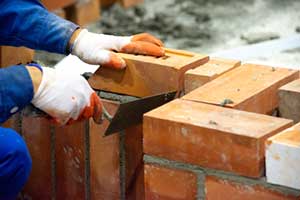Opening the Keys of Lasting Masonry Building And Construction Practices for Eco-Friendly Structures
Among the myriad methods to environment-friendly structure, lasting stonework building and construction stands out as a reliable and durable method that holds a wide range of untapped possibility. From the selection of products to innovative construction techniques, the secrets to accomplishing sustainability within masonry construction are complex and intriguing.
Advantages of Sustainable Masonry Construction
Embracing lasting stonework construction techniques not just minimizes environmental impact yet likewise uses long-term financial advantages to builders and communities. By making use of materials like recycled blocks, obstructs, and stones, home builders can considerably decrease the carbon impact of their jobs while promoting resource efficiency. Additionally, lasting stonework construction techniques, such as proper insulation and thermal mass residential or commercial properties, can improve energy effectiveness within structures, leading to reduced operational costs with time.
Moreover, the sturdiness and durability of stonework frameworks add to long-lasting economic advantages. Structures created making use of sustainable masonry methods typically need less repair and maintenance, equating to set you back financial savings for builders and homeowner. The long life of masonry materials also guarantees that structures remain stable and secure, reducing the need for frequent remodellings or substitutes.
Eco-Friendly Stonework Products
Using green stonework products is a pivotal step in the direction of boosting the sustainability of construction practices and lessening environmental influence while optimizing lasting economic benefits. Sustainable masonry materials are sourced, generated, and utilized in a way that minimizes total ecological influence. Products such as recycled blocks, redeemed rock, and sustainable concrete blocks are becoming increasingly preferred options for eco-conscious building contractors. Recycled blocks, for instance, not only divert waste from landfills yet also require less energy to produce contrasted to brand-new bricks. Reclaimed stone offers a distinct visual charm while decreasing the need for brand-new quarrying. Lasting concrete obstructs incorporate recycled accumulations and may feature better insulation residential or commercial properties, adding to power effectiveness in buildings.
Additionally, all-natural products like adobe, rammed earth, and straw bales offer exceptional thermal mass residential properties, lowering the demand for home heating and cooling down power. These products are commonly in your area offered, promoting regional economic climates and decreasing transportation-related carbon emissions. By selecting environmentally friendly masonry materials, building and construction tasks can dramatically lower their ecological impact and contribute to the creation of much healthier, extra lasting developed environments.
Energy-Efficient Masonry Techniques
Power efficiency plays an important function in boosting the sustainability of masonry building practices. One key energy-efficient stonework method is the useful reference use of thermal mass, which involves incorporating thick products like concrete or brick into the structure's structure to soak up and keep warmth.

Technologies in Sustainable Masonry
Recent innovations in sustainable masonry practices have actually produced cutting-edge strategies that are reshaping the construction industry. One such advancement is the growth of self-healing concrete, which utilizes bacteria embedded within the concrete to heal splits autonomously. This development not just lowers upkeep costs but additionally boosts the durability of masonry frameworks, adding to their sustainability.
One more remarkable development is making use of recycled accumulations in stonework building - masonry contractor. By integrating materials such as smashed ceramic waste or recycled glass right into concrete mixes, contractors can reduce the ecological effect of construction tasks while preserving structural honesty. This practice not just draws away waste from garbage dumps yet additionally preserves all-natural resources, making it an essential advancement in lasting stonework building
Moreover, the integration of electronic style tools, such as Structure Details Modeling (BIM), is reinventing the method masonry structures are intended and built. BIM permits even more exact computations, minimized material wastefulness, and enhanced power effectiveness, ultimately bring about even more lasting structure techniques. These technologies jointly symbolize an appealing future for lasting stonework building in the era of environment-friendly buildings.
Future Trends in Stonework Sustainability
With the innovative strides made in sustainable masonry practices, the future patterns in stonework sustainability are positioned to further revolutionize the construction market. One of the essential trends shaping the future of stonework sustainability is the enhanced assimilation of see here now technology. Advancements such as Structure Information Modeling (BIM) and digital reality simulations are being used to maximize stonework building and construction processes, causing reduced material waste and boosted energy performance in buildings.
Furthermore, the growth of unique lasting materials is established to play a considerable duty in anchor boosting the eco-friendliness of masonry construction. masonry contractor. Technologies like self-healing concrete, recycled accumulations, and bio-based binders are gaining grip for their ability to minimize ecological influence while maintaining architectural honesty

Conclusion
To conclude, lasting masonry building and construction practices use various benefits for environmentally friendly structures. By making use of eco-friendly materials and energy-efficient strategies, masonry can add to a more sustainable constructed setting. Developments in lasting masonry are continuously being developed to better improve the ecological performance of buildings. Looking towards the future, the trend of stonework sustainability is anticipated to expand, leading to even more environmentally friendly and energy-efficient building and construction methods in the years to find.